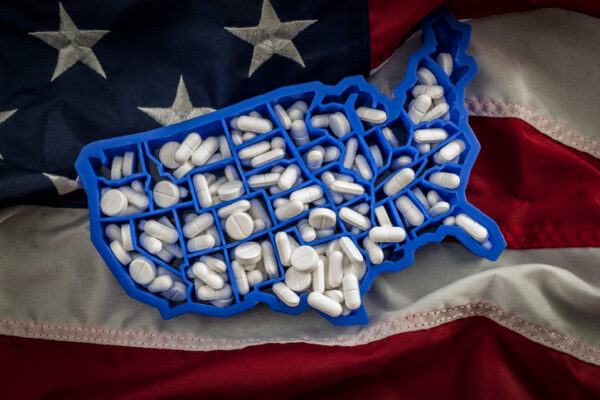
Technology is always moving forward. In the 1990s, we swapped out our box televisions with rabbit ears for flatscreens, and in the 2000s, we upgraded from flip phones to smartphones. These are among the countless examples of old technology being replaced with smaller, faster and better technology in the last 30 years.

Behavioral Health, Interoperability and eConsent: Meeting the Demands of CMS Final Rule Compliance
In a webinar on April 16 at 1pm ET, Aneesh Chopra will moderate a discussion with executives from DocuSign, Velatura, and behavioral health providers on eConsent, health information exchange and compliance with the CMS Final Rule on interoperability.
Now, the future of prescribing is moving away from the technology of the past thanks to the help of innovation, standards and regulations. In 2018, the Centers for Medicare & Medicaid Services (CMS) issued a final rule adopting the National Council for Prescription Drug Programs (NCPDP) SCRIPT Standard v2017071 for E-Prescribing and Medication History for Medicare Part D. It contains hundreds of improvements for patient safety, workflow efficiency and prescription accuracy.
The industry’s efforts to adopt this complex standard over the past several years are impressive and should be applauded. With a Centers for Medicare and Medicaid Services (CMS) deadline of January 1, 2020, virtually all pharmacies and most electronic health records software vendors (EHRs) now support the new standard. Still, there is work to be done, as not all organizations have reached the finish line. Those who are using the old standard and want to leverage, in our case, the Surescripts E-prescribing and Medication History services in the future, must complete the migration by Sep. 1.
Why Migration Must be Prioritized
Beyond the obvious benefit of achieving regulatory compliance, there are numerous other reasons why the migration to NCPDP SCRIPT Standard v2017071 should be a priority.

A Deep-dive Into Specialty Pharma
A specialty drug is a class of prescription medications used to treat complex, chronic or rare medical conditions. Although this classification was originally intended to define the treatment of rare, also termed “orphan” diseases, affecting fewer than 200,000 people in the US, more recently, specialty drugs have emerged as the cornerstone of treatment for chronic and complex diseases such as cancer, autoimmune conditions, diabetes, hepatitis C, and HIV/AIDS.
- Increases Information Sharing – The NCPDP SCRIPT Standard v2017071 includes many improvements that better share the prescriber’s intent with the pharmacy. For example, expanding the patient instructions field from a maximum of 140 characters to a maximum of 1,000 characters allows providers to share comprehensive patient instructions and eliminate delays in pharmacies. Compounded medications with up to 25 different ingredients can now be sent electronically. And prescribers can share patient allergies, preferred language and international addresses with the pharmacy.
- Reduces Administrative Burdens and Increases Patient Safety – In addition, new components of the 2017071 standard allow the provider and pharmacy to remain better aligned to improve patient safety and reduce inefficient and time-consuming faxes and phone calls. Prescribers can now cancel a prescription electronically, while pharmacists can electronically request prescriptions for medications that they have not previously dispensed. All of these workflow improvements free up prescribers and pharmacists to spend more time with patients.
In accordance with the CMS rule, migration is essential for anyone using e-prescribing or medication history transactions. This means that all EHR vendors, health systems, pharmacies and pharmacy benefit managers (PBMs) who utilize these tools must complete their migrations to SCRIPT Standard v2017071 for their users to continue to use these services.
Making the Migration as Smooth As Possible
The migration to SCRIPT Standard v2017071 takes time and work. Here are two pieces of advice to help make the transition to the new standard as smooth as possible:
- Get Started Now.
If the finish line isn’t in sight, organizations need to get started now or risk being left behind. The entire migration takes about six months—four months in development and two months conducting quality assurance testing.
- Lean On Resources
The best way to ensure the success of a complex process is to collaborate and be as prepared as possible. EHR vendors can provide guidance to their customers about how to migrate to NCPDP SCRIPT Standard v2017071. NCPDP has posted a SCRIPT Implementation Recommendations guide that can be helpful for organizations to reference if they are not sure where to start.
Every decade, substantial technological advances reflect the healthcare industry’s commitment to increasing safety, expanding interoperability and improving the quality of care. All healthcare providers and patients deserve to experience the enhancements that come with NCPDP SCRIPT Standard v2017071. And with the CMS deadline now more than 18 months behind us, healthcare has moved ahead and left the old standard behind—healthcare providers must ensure they aren’t left behind too.
Photo: Moussa81, Getty Images
Dr. Andrew Mellin is the Chief Medical Information Officer at Surescripts. Since joining in 2018, his tenure is marked by advancing strategic healthcare IT innovations and convening industry stakeholders within the Surescripts Network Alliance, focusing on key industry areas such as population health, medication adherence and affordability, specialty medications, and interoperability.
Trained in internal medicine, Dr. Mellin has brought patient-centric and provider-focused perspectives throughout the more than two decades he has spent developing and implementing innovative EHR and analytics solutions for healthcare providers.
Dr. Mellin previously led the provider engagement team at Allina Health in Minneapolis for an EHR implementation that spanned eight hospitals and 60 clinics. He also worked as a hospitalist in St. Paul, Minnesota for 15 years.












